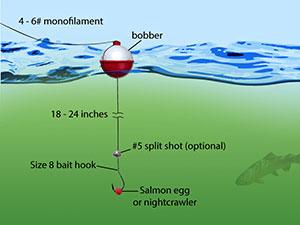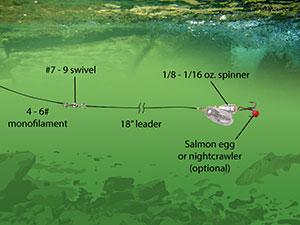Fishing for cold water trout with a spin cast rod and reel can be an art form based on many factors and variables in the environment and the rig you are using determines how this finicky fish will react when presented with a live or artificial bat. What are the best trout setups for beginners?
3 Best Beginner Setups for Trout Rigs:
- Rigs that present bait suspended underneath a float
- Rigs that present the bait at/near the bottom
- Rigs that allow you to cast & retrieve artificial lures like the Rooster Tail based on color, baitfish, or insect type for catching Rainbow & most species of Trout
Using a sliding sinker allows the fish to grab the bait and not feel the weight, which could make the trout spit out the hook. The size of the weight depends on the season of the year and where the Rainbow Trout is in the water column.
Trout Fishing Setup for Beginners
There are three basic rig setups for catching trout. They include:
- Rigs that present bait suspended underneath a float
- Rigs that present the appeal at the bottom of the water column near the bottom
- Rigs that allow you to cast and retrieve an artificial lure.
These freshwater Trout fishing rigs are ideal for rainbow and other species of trout fishing. Study each rig to determine which will be most effective for the trout you are targeting and the fishing conditions.
Essential Trout Fishing Setups and Rigs for Beginners
Slip Sinker Rig- this trout fishing rig is perfect to use when fishing in shallow water approximately 10-15 feet deep when trout fish are sitting near the bottom. You can cast it a good distance from the shoreline which makes covering a lot of ground quick and easy.
Split Shot Rig trout rig is perfect for use when trout are being finicky which also makes ideal for use in small watersand or clear ones. Fishing this rig is simple, just cast out as far as you can and let it sink to the bottom. Slowly retrieve the rig back to you using jigging and pause movements. Keeping the lure moving and at different depths to tempt the trout. Try changing the retrieve speed to catch the attention of trout if a slow one doesn’t work.
Spinner The spinner rig is the most commonly used Rainbow trout fishing lure rig and it uses a spinner lure in conjunction with or without split shots. You can put any lyre on the end of this rig you like but the spinning action does make trout go a little crazy.
The shiny spinner makes a lot of noise and trout come from far to see what it is and eat it. To fish it, simply cast it out, let it sink for as long as you like, and then slowly retrieve it in to make sure the spinner is moving well. Don’t wind too fast or too slow as the spinner is designed for that and will jump or not spin enough to attract some fish.
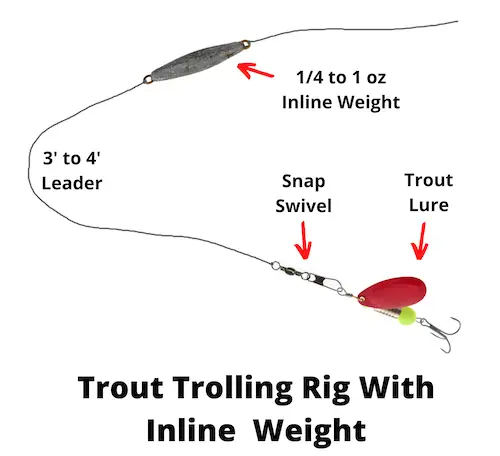


Rigs That Present the Bait At or Near the Bottom
When targeting trout with bait presentations near or at the bottom, anglers often use rigs that effectively keep the bait close to the lake or riverbed where trout tend to forage. Here are two common setups for presenting bait at or near the bottom:
-
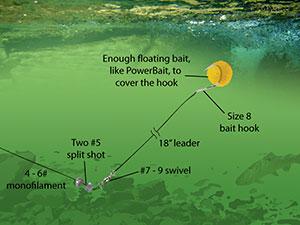
floating bait rig for fishing Bottom Rig with Weight:
- This rig is straightforward and relies on weight to keep the bait anchored near the bottom.
- To set up the rig:
- Slide a weight (such as a split shot or eggsinker) onto the main fishing line.
- Tie on a small swivel to prevent the weight from sliding down further.
- Below the swivel, tie on a leader line of appropriate length (usually 12-18 inches).
- Attach a small hook (size 10 to 14) to the end of the leader line using an improved clinch knot or Palomar knot.
- Thread your preferred bait onto the hook, such as worms, PowerBait, or salmon eggs.
- Cast the rig into the desired area and allow it to sink to the bottom. Monitor your line for bites and adjust your presentation as needed.
- Drop Shot Rig:
- The drop shot rig is another effective setup for presenting bait near the bottom, providing more finesse and sensitivity.
- To set up the rig:
- Tie a hook (size 10 to 14) to the end of the main fishing line using an improved clinch knot or Palomar knot.
- Leave a tag end of 12 to 18 inches and tie a small weight (such as a drop shot weight or split shot) to this tag end.
- Attach your preferred bait to the hook, ensuring it is rigged securely.
- Cast the rig into the desired area and allow it to sink to the bottom. Keep your line taut and watch for subtle bites or movements.
Both of these rigs are effective for presenting bait near the bottom, where trout often feed on insects, baitfish, and other organisms. Experiment with different baits and weights to find the most productive setup for the conditions and trout behavior in your fishing spot. Additionally, be aware of local fishing regulations and practice responsible angling techniques to protect trout populations and their habitat.
Essential Trout Fishing Tackle
- Spinning Rod and Reel Combo:
- Choose a 6-7 ft ultralight or light rod.
- Pair it with a reel that holds a 4-8 lb test monofilament line.
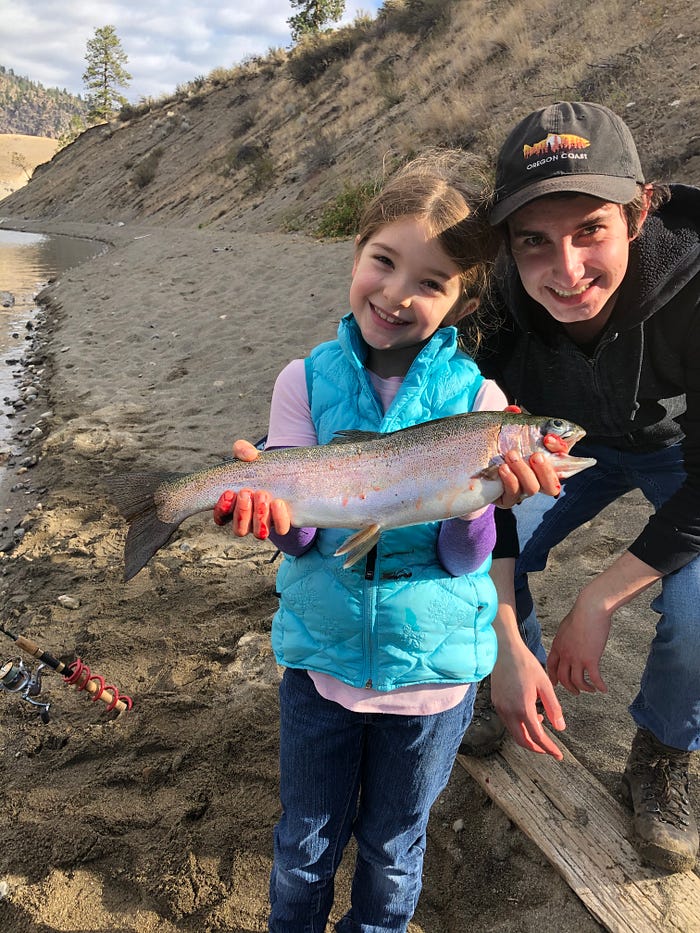
Trout Beginner
- Basic Bait Rig:
- Use a single-hook bait rig for simplicity.
- Popular baits include live worms, powerbait, or small spinners.
- Adjustable Weights:
- Adapt weight based on current conditions.
- Vary weights to reach different depths and adapt to the water flow.
- Bobbers or Floats:
- Include bobbers to suspend the bait at desired depths.
- Adjust the bobber position based on the trout’s location.
- Leader Material:
- Have leaders of varying lengths for different situations.
- Use fluorocarbon leaders for better invisibility in clear water.
- Landing Net:
- Carry a landing net to safely bring in your catch.
- Ensure it’s appropriate for trout size.
- Polarized Sunglasses:
- Enhance visibility to spot fish and understand underwater structures.
- Tackle Box:
- Organize with a variety of hooks, swivels, and extra lines.
- Include pliers and line cutters.
- Knowledge of Local Regulations:
- Understand and adhere to fishing regulations in your area.
- Be aware of size limits and catch-and-release policies.
- Patience and Observation:
- Trout fishing requires patience and keen observation.
- Watch for signs like ripples, rising fish, or insect activity.
Remember, adapt your setup based on specific conditions, and continuous learning will enhance your trout fishing experience.
Where To Find The Trout
Trout can be found in a variety of aquatic habitats, and locating them often depends on factors such as water temperature, depth, oxygen levels, food availability, and shelter. Here are some common places where you can find trout:
How Do You Tell the Difference Between Species of Trout?
3 primary species of trout:
Brown Trout-brownish-yellow color-scattered black, red,& orange spots on their sides-12″ long or less
Brook Trout-(Speckled trout) brown with reddish fins & white tips-8″ long or less
Rainbow Trout-dark back & white belly-pink stripe down middle-up to 12″ long are common .……………………………………………………………………. Read more
Conclusion:
As you pull on your waders and gather your gear, remember that simplicity is the soul of a successful trout fishing setup. Whether you opt for a spinning setup with a light line and a trusty in-line spinner or float a fly with grace and precision, the magic lies in patience, practice, and the delicate balance of being prepared without overcomplicating your tackle box. Embrace these essential rigs and setups, and you’ll be on your way to not only mastering the serene art of trout fishing but also cherishing the tranquil dance with nature that every cast promises.
What is the Best Trout Bait For Stocked Trout?
Baits:
- Wax worms
- Red worms
- Nightcrawlers
- Salmon eggs
- Powerbait- the #1 choice for catching stocked trout fed from pellets
- Corn-old hands in the trout business swear by it
- Minnows- It doesn’t take long for stocked trout to acclimate to their new environment.
- Lures: Shiny Spoons & the Famous Rooster Tail .……………………………………………………………………………………………… Read more

References:
 –
–
TROUT FISHING FOR BEGINNERS: 15 TIPS & COMPLETE SETUP GUIDE
FAQ’s
Q: What is the essential gear for a beginner angler aiming to catch trout?
A: The essential gear for a beginner angler includes a lightweight rod and reel, matched with a supple line. Together, they form the basic setup for trout fishing.
Q: What type of rig is recommended for rookie trout anglers?
A: For rookies, a simple hook-and-bait duo is the quintessential trout rig. It should be balanced with the right bait to mimic the natural diet of the trout species being targeted.
Q: How important is the choice of bait in trout fishing?
A: The choice of bait is critical as trout are particular about their diet. Using the right bait that reflects their natural prey is key to attracting trout and improving your chances of a successful catch.
Q: What should beginners know about the rod and reel setup for trout fishing?
A: Beginners should select a rod with suitable flex and action to ensure smooth and effective casting. The reel should be well-matched with the rod to streamline the learning process, allowing the beginner to focus more on the fishing technique and experience.
Q: Are there any specific techniques beginners should learn for fly fishing for trout?
A: Yes, beginners should learn how to cast flies such as nymphs, streamers, and dry flies, which are designed to mimic the natural prey of trout. Mastering the casting technique and understanding the behavior of these flies in the water can greatly increase the chances of a successful catch in fly fishing scenarios.

